calsfoundation@cals.org
Minnijean Brown Trickey (1941–)
Minnijean Brown Trickey made history as one of the Little Rock Nine, the nine African American students who desegregated Little Rock Central High School in 1957. The world watched as they braved constant intimidation and threats from those who opposed desegregation of the formerly all-white high school.
Minnijean Brown, the eldest of four children of Willie and Imogene Brown, was born on September 11, 1941, in Little Rock (Pulaski County). Her mother was a homemaker and nurse’s aid during the crisis, and her father was an independent mason and landscaping contractor. She is the sister of the late Bobby Brown, who was the president of Black United Youth (BUY) in Arkansas in the late 1960s.
Although all of the Nine experienced verbal and physical harassment during the 1957–58 academic year at Central, Trickey was first suspended, and then expelled, for retaliating against the daily torment: specifically, she called one of her tormenters “white trash.” On February 17, 1958, she moved to New York and lived with Drs. Kenneth B. and Mamie Clark, African-American psychologists whose social science research formed the basis for the National Association for the Advancement of Colored People (NAACP) argument in the Brown v. Board of Education of Topeka, Kansas case, which held that segregation harmed the self-esteem of African-American children. She graduated from New York’s New Lincoln School, a private progressive school in Manhattan, in 1959.
Brown married Roy Trickey, a fisheries biologist, on September 21, 1967; they have six children. She attended Southern Illinois University and majored in journalism. She later moved to Canada with her husband, who was a conscientious objector during the Vietnam War, where she received a BSW in Native Human Services from Laurentian University and an MSW in social work from Carleton University in Ontario, Canada. The couple divorced in the mid-1980s.
Trickey is a social activist and has worked on behalf of peacemaking, environmental issues, developing youth leadership, diversity education and training, cross-cultural communication, and gender and social justice advocacy. She served in the Clinton administration as Deputy Assistant Secretary for Workforce Diversity at the Department of the Interior from 1999 to 2001. She has taught social work at Carleton University in Ottawa Canada and in various community colleges in Canada.
Trickey worked for an interactive traveling trip called Sojourn to the Past, a ten-day interactive history experience through selected U.S. states with 100 high school students learning about the civil rights movement. She was also a guest lecturer at Arkansas State University (ASU) in Jonesboro (Craighead County). She was the recipient of the Mary Gay Shipley Writing Fellowship, as a part of ASU’s Heritage Studies PhD program. She is also the subject of a documentary, Journey to Little Rock: The Untold Story of Minnijean Brown Trickey.
Trickey is the recipient of numerous awards for her community work for social justice, including the Lifetime Achievement Tribute by the Canadian Race Relations foundation and the International Wolf Award for contributions to racial harmony. Trickey, along with the other Little Rock Nine and Daisy Bates, was awarded the prestigious Spingarn Medal by the NAACP in 1958. In 1999, President Bill Clinton presented the nation’s highest civilian award, the Congressional Gold Medal, to the members of the Little Rock Nine. After living in Little Rock for several years, she returned to Canada in early 2012. Several items from her time at Central, including her suspension notice, are held in the collections of the National Museum of American History.
For additional information:
Andrews, Kehinde.”Minnijean Brown-Trickey: The Teenager Who Needed an Armed Guard to Go to School.” The Guardian, November 26, 2020. https://www.theguardian.com/society/2020/nov/26/minnijean-brown-trickey-little-rock-nine (accessed July 11, 2023).
Bates, Daisy. The Long Shadow of Little Rock. Fayetteville: University of Arkansas Press, 1986.
Beals, Melba Pattillo. Warriors Don’t Cry: A Searing Memoir of the Battle to Desegregate Little Rock’s Central High School. New York: Washington Square Books, 1994.
Collins, Janelle. “‘It Was a Form of Creativity, Our Going to Central’: An Interview with Minnijean Brown Trickey.” Arkansas Review: A Journal of Delta Studies 36 (August 2005): 90–98.
Harvey, Lucy. “A Member of the Little Rock Nine Discusses Her Struggle to Attend Central High.” Smithsonian.com, April 22, 2016. http://www.smithsonianmag.com/smithsonian-institution/member-little-rock-nine-discusses-her-struggle-attend-central-high-180958870/?no-ist (accessed July 11, 2023).
Jacoway, Elizabeth. “Not Anger but Sorrow: Minnijean Brown Trickey Remembers the Little Rock Crisis.” Arkansas Historical Quarterly 64 (Spring 2005): 1–26.
Jacoway, Elizabeth, and C. Fred Williams, eds. Understanding the Little Rock Crisis: An Exercise in Remembrance and Reconciliation. Fayetteville: University of Arkansas Press, 1999.
Roy, Beth. Bitters in the Honey: Tales of Hope and Disappointment across Divides of Race and Time. Fayetteville: University of Arkansas Press, 1999.
Thompson, Rob, director. Journey to Little Rock: The Untold Story of Minnijean Brown Trickey. Documentary film. Canada: North East Productions, 2001.
Trickey, Minnijean Brown, and Phyllis Brown. “StoryCorps: Interview with Minnijean Brown Trickey and Phyllis Brown.” October 15, 2006. Audio at Butler Center for Arkansas Studies, Bobby L. Roberts Library of Arkansas History & Art, Central Arkansas Library System: Minnijean Brown Trickey and Phyllis Brown Interview (accessed July 11, 2023).
National Park Service
Central High School National Historic Site
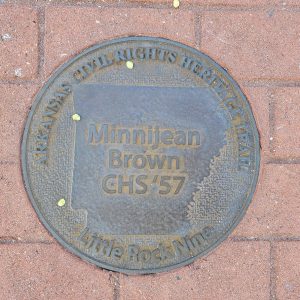 Brown Marker
Brown Marker 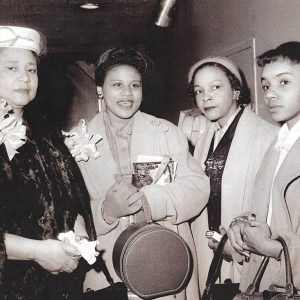 Minnijean Brown
Minnijean Brown 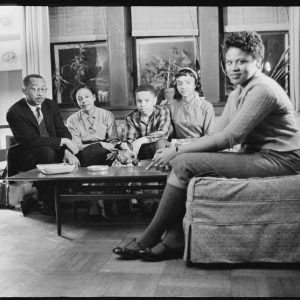 Minnijean Brown and Clarks
Minnijean Brown and Clarks 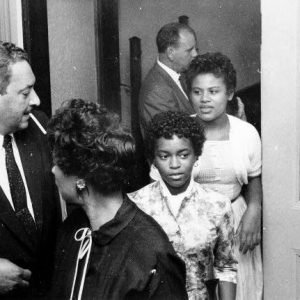 Central High Students Leaving Federal Court, 1957
Central High Students Leaving Federal Court, 1957  Little Rock Nine Way
Little Rock Nine Way 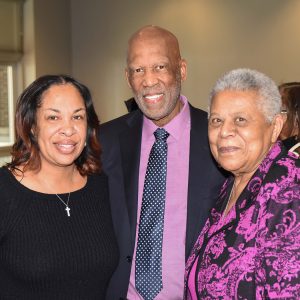 Mays, Roberts, Trickey
Mays, Roberts, Trickey 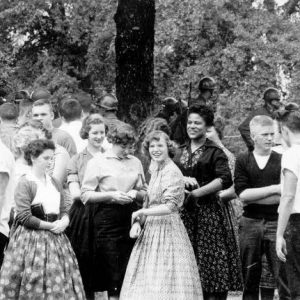 Minnijean Brown with Classmates
Minnijean Brown with Classmates 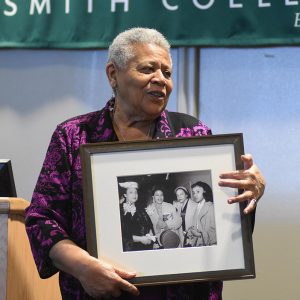 Minnijean Brown Trickey
Minnijean Brown Trickey 



Comments
No comments on this entry yet.